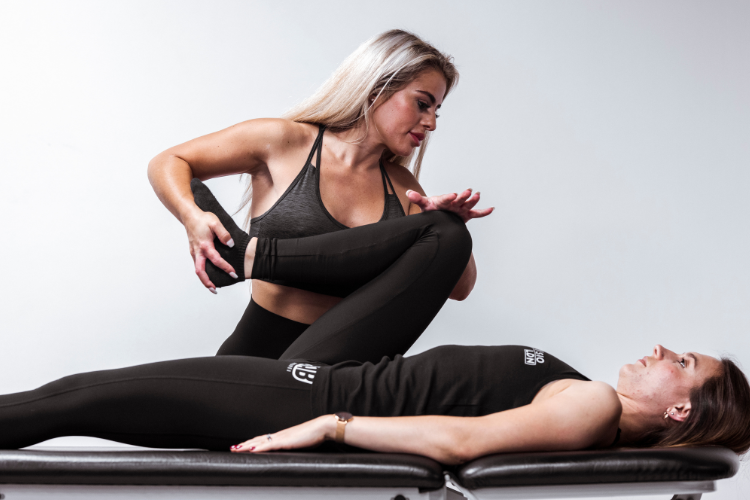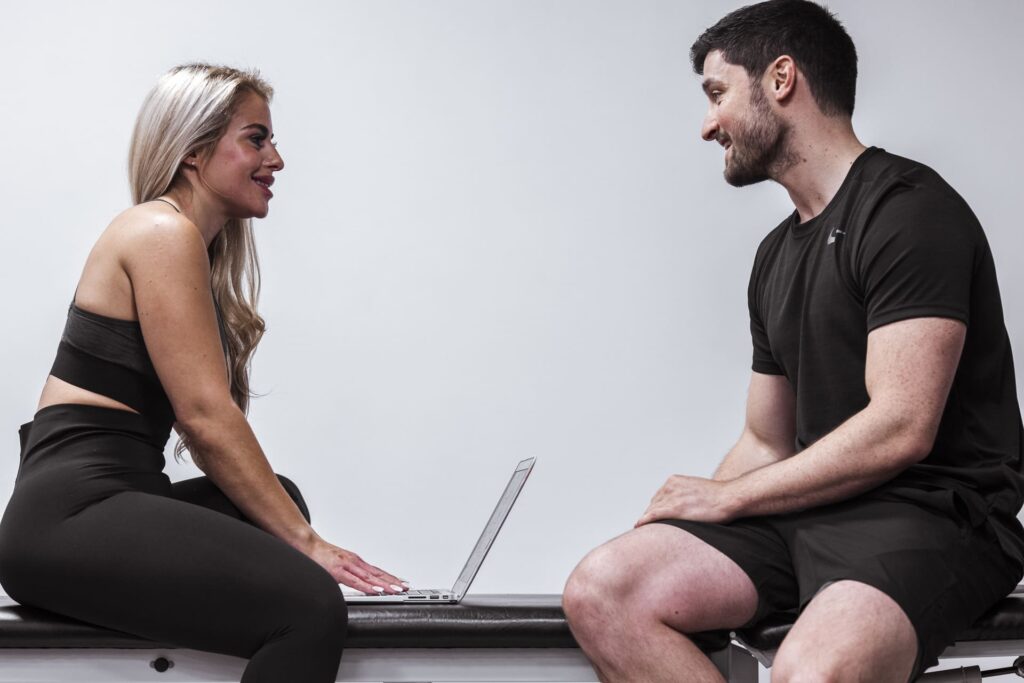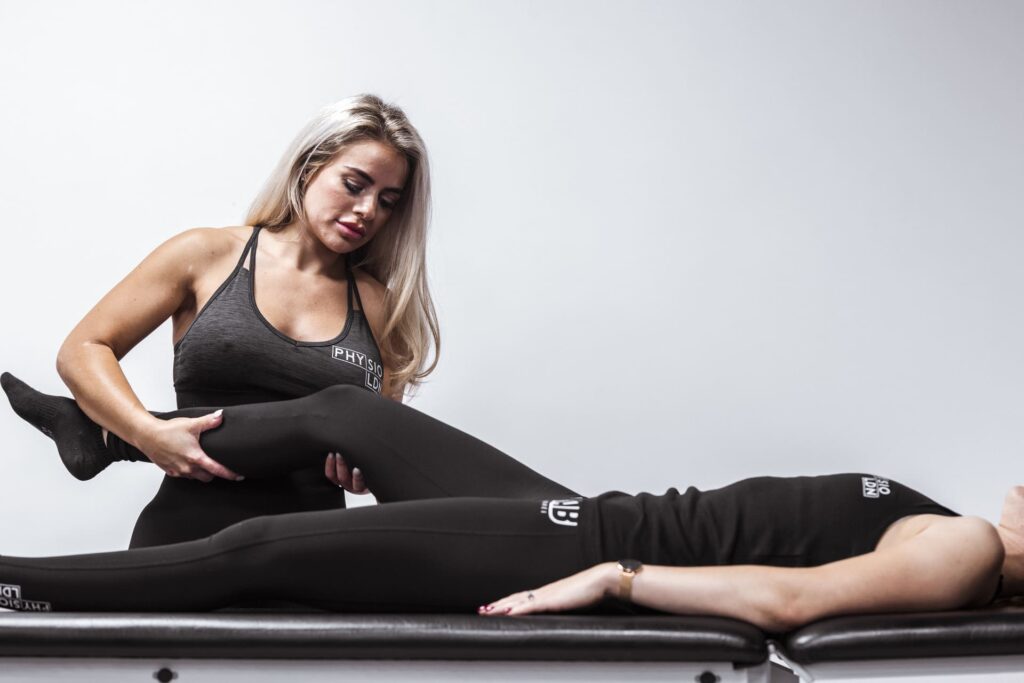Table of Contents
Main Takeaways
- Common but fixable: Walking can flare knee pain with OA, prior injury, weak muscles, or poor gait.
- Load alert: 2025 review—walking creates the highest knee load in OA among daily tasks.
- Why it hurts: OA, quad/hip weakness, excess weight, bad footwear/mechanics, central sensitization.
- What helps now: RICE, quad/ham/hip strengthening, supportive shoes, low-impact cardio, weight management, anti-inflammatory diet.
- Emerging win: Gait retraining (foot angle/stride tweaks) cuts pain and may slow cartilage loss (Stanford/Utah).
- Protective factors: Strong quads + lower BMI → better odds of pain resolution (MOST Study).
- ACL note: ~60% of women still report symptoms at 6 months post-op—even with normal gait.
- See a pro if: Pain, swelling, locking, or instability persist.
- Best care: One Body LDN—expert MSK physio, deep-tissue massage, and personalized rehab.
Knee pain after walking is a common complaint that affects people of all ages and activity levels. Whether it’s a mild discomfort or a sharp ache, understanding the causes and management of knee pain is essential for maintaining mobility and quality of life. Walking, while generally beneficial for health, can sometimes exacerbate underlying knee issues, especially in individuals with conditions like osteoarthritis or previous injuries.
Studies have shown that walking generates significant knee loading, which can contribute to pain in susceptible individuals. In fact, a systematic review found that walking leads to the greatest knee loading among daily activities in people with knee osteoarthritis. This highlights the importance of understanding how walking mechanics impact knee health and what can be done to alleviate discomfort.
In this article, we explore why knee pain occurs after walking, practical at-home relief tips, and when it’s crucial to seek professional help. With insights from recent research and expert knee pain physiotherapy advice, this guide aims to empower you to manage knee pain effectively and maintain an active lifestyle.
Why Pain Occurs Post-Walk
Knee pain after walking often stems from increased mechanical stress on the joint structures, including cartilage, ligaments, and muscles. Walking, despite being a low-impact activity, places repetitive load on the knee, which can aggravate existing conditions such as osteoarthritis, meniscal tears, or ligament injuries.

Osteoarthritis is one of the most common causes of knee pain post-walking. The degradation of cartilage leads to bone-on-bone contact, causing inflammation and discomfort. Research indicates that gait retraining—adjusting how a person walks—can reduce knee load and potentially slow cartilage degradation. Scott Uhlrich, assistant professor at the University of Utah, emphasizes that gait retraining holds promise for alleviating pain and improving joint health in osteoarthritis patients.
Additionally, a 2025 study demonstrated that personalized gait retraining involving slight adjustments to foot angles can significantly reduce knee pain and slow cartilage damage in osteoarthritis patients, underscoring the role of biomechanics in knee health (Stanford News).
Other factors contributing to knee pain after walking include muscle weakness, particularly in the quadriceps, and excess body weight. The Multicenter Osteoarthritis Study (MOST) found that participants with stronger quadriceps and lower BMI had higher odds of knee pain resolution over time, highlighting the importance of muscle strength and weight management (MOST Study).
Post-surgical conditions, such as anterior cruciate ligament (ACL) reconstruction, can also cause knee pain during walking. Interestingly, a study revealed that although nearly 60% of women reported significant knee symptoms six months after ACL reconstruction, their walking biomechanics were not significantly affected at that stage (ACL Reconstruction Study), suggesting that pain and movement patterns do not always correlate directly.
Moreover, the psychological aspect of pain perception cannot be overlooked. Studies have shown that individuals with chronic knee pain often develop a heightened sensitivity to pain, which can exacerbate their condition.
This phenomenon, known as central sensitization, occurs when the nervous system becomes overly responsive to stimuli, leading to increased pain perception even in the absence of significant physical injury. Understanding this relationship between the mind and body is crucial for developing effective pain management strategies.
Additionally, footwear plays a significant role in knee health during walking. The type of shoes worn can influence gait mechanics, potentially leading to increased stress on the knees. Research suggests that shoes with inadequate support or cushioning can contribute to misalignment and improper weight distribution, further aggravating knee pain.
Therefore, selecting appropriate footwear that provides adequate support and aligns with an individual’s walking style is essential for minimizing discomfort and promoting overall joint health.
At-Home Relief Tips
Managing knee pain at home after walking involves a combination of strategies aimed at reducing inflammation, improving strength, and optimizing movement patterns. Here are some effective tips to help alleviate knee discomfort:
- Rest and Ice: After a walk that causes pain, resting the knee and applying ice can reduce inflammation and swelling. Ice should be applied for 15-20 minutes every few hours during the initial phase of pain.
- Strengthening Exercises: Building strength in the quadriceps, hamstrings, and hip muscles supports the knee joint and improves stability. Exercises such as straight leg raises, wall sits, and gentle squats can be beneficial. Stronger muscles help distribute load more evenly, reducing knee stress.
- Gait Retraining: As highlighted by recent research, slight modifications to walking technique, such as adjusting foot angles, can reduce knee joint forces. Working with a physiotherapist to learn these adjustments can be highly effective (movement optimization study).
- Weight Management: Maintaining a healthy weight reduces the load on the knee during walking and other activities. Even modest weight loss can significantly decrease knee joint stress and pain.
- Use of Supportive Footwear: Wearing shoes with good arch support and cushioning can help absorb impact and improve walking mechanics, thereby reducing knee strain.
- Low-Impact Activities: Incorporating low-impact exercises such as swimming or cycling can maintain cardiovascular fitness without exacerbating knee pain.
Regular walking itself may help prevent knee pain development in osteoarthritis, according to a Harvard Health report. This underscores the importance of maintaining activity levels while managing pain appropriately.
In addition to these strategies, consider integrating flexibility and stretching routines into your daily regimen. Gentle stretches targeting the muscles around the knee can enhance mobility and reduce tightness, which may contribute to discomfort. Techniques such as yoga or Pilates not only promote flexibility but also encourage body awareness, helping you to identify and correct any movements that might be placing undue stress on your knees.
Furthermore, exploring natural anti-inflammatory remedies may provide additional relief. Turmeric, for instance, contains curcumin, a compound known for its anti-inflammatory properties. Incorporating turmeric into your diet, whether through cooking or as a supplement, could complement your pain management efforts. Always consult with a healthcare professional before starting any new supplement, especially if you are already taking medication or have underlying health conditions.
When to Seek Help
While mild knee pain after walking can often be managed at home, certain signs indicate the need for knee pain professional assessment and treatment. Seek medical advice if you experience:

- Persistent or worsening knee pain that does not improve with rest and home care.
- Swelling, redness, or warmth around the knee joint.
- Inability to bear weight or walk without significant discomfort.
- Locking or catching sensations in the knee.
- History of recent injury or surgery with ongoing symptoms.
Physiotherapy plays a vital role in diagnosing and treating knee pain. Expert physiotherapists provide thorough assessments to identify the root cause and tailor treatment plans that may include hands-on therapy, exercise rehabilitation, and gait retraining. London’s One Body LDN clinic, for example, offers award-winning physiotherapy services with clinicians who receive over five times the required regulatory training, ensuring high-quality care for knee pain and related conditions (One Body LDN Physiotherapy).
Early intervention can prevent chronic pain and improve long-term outcomes. For individuals recovering from surgery or managing chronic conditions like osteoarthritis, professional guidance is essential to restore function and reduce pain effectively. Additionally, physiotherapists often incorporate modalities such as ultrasound therapy, electrical stimulation, or manual therapy techniques to enhance recovery.
These methods can help reduce inflammation, alleviate pain, and promote healing, allowing patients to return to their daily activities more swiftly.
Moreover, understanding the biomechanics of the knee and how it interacts with the surrounding muscles and joints is crucial for effective knee pain treatment. A comprehensive approach may also include education on proper body mechanics, ergonomic adjustments for daily tasks, and strategies to prevent future injuries.
This holistic perspective ensures that patients are not only treated for their current pain but are also empowered with knowledge and tools to maintain their knee health over the long term.
FAQ
What causes knee pain after walking?
Knee pain after walking is often caused by increased mechanical stress on the joint, underlying conditions such as osteoarthritis, muscle weakness, or previous injuries. Walking generates significant knee loading, which can exacerbate these issues. Additionally, factors such as improper footwear, uneven terrain, or poor walking posture can also contribute to discomfort. The knee joint is a complex structure, and even minor misalignments can lead to pain, especially after prolonged activity.
Can walking worsen knee osteoarthritis?
Walking can increase knee load, but regular, controlled walking may actually help reduce the risk of developing knee pain in osteoarthritis. Personalized gait retraining can further reduce knee joint stress and slow cartilage damage. Engaging in low-impact activities, such as swimming or cycling, can complement walking routines and provide a balanced approach to joint health. It’s essential to listen to your body and adjust your walking intensity based on how your knees respond to avoid exacerbating any existing conditions.
How can I reduce knee pain after walking?
Rest, ice, strengthening exercises, gait retraining, weight management, and supportive footwear are effective at-home strategies to alleviate knee pain after walking. Incorporating flexibility exercises and stretching routines can also enhance joint mobility and reduce stiffness. Additionally, using knee braces or orthotic inserts can provide extra support and help distribute weight more evenly across the joint, further mitigating pain during and after walking.
When should I see a physiotherapist for knee pain?
If knee pain persists, worsens, or is accompanied by swelling, instability, or difficulty walking, it is important to seek professional assessment. Physiotherapists can provide targeted treatments and rehabilitation plans. They may also employ modalities such as ultrasound therapy or electrical stimulation to promote healing. Early intervention is key, as addressing issues promptly can prevent further complications and aid in a quicker recovery.
Is knee pain after ACL surgery normal?
Yes, many patients experience knee symptoms after ACL reconstruction. However, these symptoms may not significantly affect walking biomechanics six months post-surgery. Ongoing physiotherapy is important for recovery. Patients are often encouraged to engage in specific rehabilitation exercises that focus on strength, stability, and range of motion, which are crucial for returning to pre-injury activity levels. Understanding the healing process and setting realistic recovery goals can also help manage expectations during rehabilitation.
Can gait retraining help with knee pain?
Yes, gait retraining involving slight adjustments to walking patterns can reduce knee joint forces, alleviate pain, and potentially slow cartilage degradation in osteoarthritis patients. This process often includes analyzing walking mechanics and identifying maladaptive patterns that may contribute to pain. By making small, targeted changes, individuals can improve their overall biomechanics, leading to more efficient movement and reduced strain on the knees.
Does weight affect knee pain?
Excess weight increases knee joint load during walking, contributing to pain and cartilage wear. Lowering BMI is associated with higher chances of knee pain resolution. Furthermore, weight loss can lead to improved physical function and quality of life, making it easier to engage in physical activities that promote joint health. Nutritional counseling and lifestyle modifications can play a significant role in achieving and maintaining a healthy weight, thereby alleviating stress on the knees. For detail information see our blog knee pain and weight: causes, relief & weight loss tips.
Are there clinics in London specializing in knee pain physiotherapy?
Yes, clinics like One Body LDN in London specialize in musculoskeletal physiotherapy, offering expert assessment, hands-on treatment, and personalized rehab plans for knee pain and injuries. These clinics often employ a multidisciplinary approach, integrating physiotherapy with other modalities such as chiropractic care, acupuncture, and massage therapy. This comprehensive treatment strategy can enhance recovery and provide patients with a holistic understanding of their knee health, empowering them to take an active role in their rehabilitation journey.
Take the First Step Towards Knee Pain Relief with One Body LDN
If knee pain is slowing you down after your walks, it’s time to address the root cause with One Body LDN, voted as the best London physio clinic. Our award-winning team of physiotherapy experts is dedicated to providing you with a precise diagnosis and a tailored treatment plan that blends exercise rehab and deep tissue massage. Specializing in musculoskeletal physiotherapy and sports injuries, we’re equipped to handle everything from gym injuries to post-operative care. Don’t let knee pain become a long-term issue. Book your free initial assessment at our clinic today and experience instant pain relief and a path to feeling amazing. Book your free initial assessment and take the first step towards a pain-free life.


